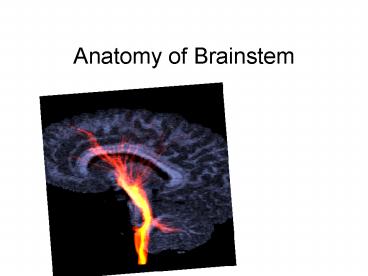Anatomy of Brainstem - PowerPoint PPT Presentation
1 / 30
Title:
Anatomy of Brainstem
Description:
Anatomy of Brainstem Anatomy of derivative of the Metencephalon and Mesencephalon Midbrain Located btwn the diencephalon and the pons. 2 bulging cerebral peduncles on ... – PowerPoint PPT presentation
Number of Views:155
Avg rating:3.0/5.0
Title: Anatomy of Brainstem
1
Anatomy of Brainstem
2
- Anatomy of derivative of the Metencephalon and
Mesencephalon
3
(No Transcript)
4
(No Transcript)
5
(No Transcript)
6
Midbrain
- Located btwn the diencephalon and the pons.
- 2 bulging cerebral peduncles on the ventral side.
These contain - Descending fibers that go to the cerebellum via
the pons - Descending pyramidal tracts
- Running thru the midbrain is the hollow cerebral
aqueduct which connects the 3rd and 4th
ventricles of the brain. - The roof of the aqueduct ( the tectum) contains
the corpora quadrigemina - 2 superior colliculi that control reflex
movements of the eyes, head and neck in response
to visual stimuli - 2 inferior colliculi that control reflex
movements of the head, neck, and trunk in
response to auditory stimuli
7
(No Transcript)
8
(No Transcript)
9
Midbrain
- Located btwn the diencephalon and the pons.
- 2 bulging cerebral peduncles on the ventral side.
These contain - Descending fibers that go to the cerebellum via
the pons - Descending pyramidal tracts
- Running thru the midbrain is the hollow cerebral
aqueduct which connects the 3rd and 4th
ventricles of the brain. - The roof of the aqueduct ( the tectum) contains
the corpora quadrigemina - 2 superior colliculi that control reflex
movements of the eyes, head and neck in response
to visual stimuli - 2 inferior colliculi that control reflex
movements of the head, neck, and trunk in
response to auditory stimuli
10
- Cranial nerves 34 (oculomotor and trochlear)
exit from the midbrain - Midbrain also contains the headquarters of the
reticular activating system
11
Midbrain
- On each side, the midbrain contains a red nucleus
and a substantia nigra - Red nucleus contains numerous blood vessels and
receives info from the cerebrum and cerebellum
and issues subconscious motor commands concerned
w/ muscle tone posture - Lateral to the red nucleus is the
melanin-containing substantia nigra which
secretes dopamine to inhibit the excitatory
neurons of the basal nuclei. - Damage to the substantia nigra would cause what?
12
(No Transcript)
13
Pons
- Literally means bridge
- Wedged btwn the midbrain medulla.
- Contains
- Sensory and motor nuclei for 4 cranial nerves
- Trigeminal (5), Abducens (6), Facial (7),
- and Auditory/Vestibular (8)
- Respiratory nuclei
- Apneustic pneumotaxic centers work w/ the
medulla to maintain respiratory rhythm - Nuclei tracts that process and relay info
to/from the cerebellum - Ascending, descending, and transverse tracts that
interconnect other portions of the CNS
14
Medulla Oblongata
- Most inferior region of the brain stem.
- Becomes the spinal cord at the level of the
foramen magnum. - Ventrally, 2 ridges (the medullary pyramids) are
visible. - These are formed by the large motor corticospinal
tracts. - Right above the medulla-SC junction, most of
these fibers cross-over (decussate).
15
(No Transcript)
16
Medulla Oblongata
- Nuclei in the medulla are associated w/ autonomic
control, cranial nerves, and motor/sensory relay. - Autonomic nuclei
- Cardiovascular centers
- Cardioinhibitory/cardioacceleratory centers alter
the rate and force of cardiac contractions - Vasomotor center alters the tone of vascular
smooth muscle - Respiratory rhythmicity centers
- Receive input from the pons
- Additional Centers
- Emesis, deglutition, coughing, hiccupping, and
sneezing
17
Medulla Oblongata
- Sensory motor nuclei of 5 cranial nerves
- Auditory/Vestibular (8), Glossopharyngeal (9),
Vagus (10), Accessory (11), and Hypoglossal (12) - Relay nuclei
- Nucleus gracilis and nucleus cuneatus pass
somatic sensory information to the thalamus - Olivary nuclei relay info from the spinal cord,
cerebral cortex, and the brainstem to the
cerebellar cortex.
18
(No Transcript)
19
(No Transcript)
20
(No Transcript)
21
(No Transcript)
22
(No Transcript)
23
24
(No Transcript)
25
(No Transcript)
26
What brainstem structures are visible here?
27
Limbic System
- Includes nuclei and tracts along the border btwn
the cerebrum and the diencephalon. - Functional grouping rather than anatomical
- Functions include
- Establishing emotional states
- Linking conscious cerebral cortical functions w/
unconscious functions of the brainstem - Facilitating memory storage and retrieval
- Limbic lobe of the cerebrum consists of 3 gyri
that curve along the corpus callosum and medial
surface of the temporal lobe. - Limbic system ? the center of emotion anger,
fear, sexual arousal, pleasure, and sadness.
28
Reticular Formation
- Extensive network of neurons that runs thru the
medulla and projects to thalamic nuclei that
influence large areas of the cerebral cortex. - Midbrain portion of RAS most likely is its center
- Functions as a net or filter for sensory input.
- Filter out repetitive stimuli. Such as?
- Allows passage of infrequent or important stimuli
to reach the cerebral cortex. - Unless inhibited by other brain regions, it
activates the cerebral cortex keeping it alert
and awake.
How might the sleep centers of your brain work?
Why does alcohol make you tired?
29
Protection
- What is the major protection for the brain?
- There are also 3 connective tissue membranes
called the meninges - Cover and protect the CNS
- Protect blood vessels
- Contain cerebrospinal fluid
- The 3 meninges from superficial to deep
- Dura mater
- Arachnoid mater
- Pia mater
30
Skin
Galea Aponeurotica
Connective Tissue
Bone
Dura Mater
Arachnoid mater































